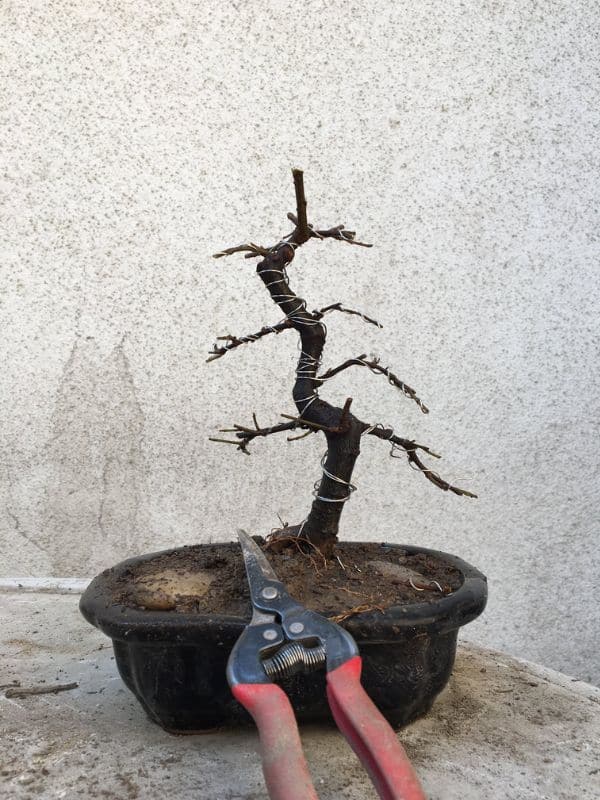Pruning is one of the most common methods used if you want to transform an ordinary tree into a bonsai tree. With the right pruning methods, you can manipulate your tree to grow into a certain shape, and these maintenance tasks are also important for keeping the tree small and miniaturized.
Regular pruning also offers many other benefits since this process encourages new growth and helps maintain the shape and aesthetics of older trees.
Pruning your bonsai can be stressful and challenging. Many bonsai artists need help with pruning techniques during the first few attempts.
In this guide, we will share some practical tips on how to prune a mini tree and explain some of the most common pruning methods you should know about before you make the first cut into your little tree.

When Should You Prune Bonsai Trees?
The pruning schedule for bonsai trees varies for different species of trees, as well as the type of pruning method you will use.
Deciduous trees are typically hard-pruned or structurally pruned in early spring or late winter before the growing season and before new growth starts appearing on these trees. This is because hard pruning can boost some healthy new growth, and it is much easier to see the natural branch pattern of your tree when all the leaves have fallen off.
Evergreen trees can be pruned throughout the year because these trees grow year-round.
Maintenance pruning is usually very light and can be done throughout the year because this method is designed to maintain the shape of the tree so it will look beautiful.
What Happens if You Don’t Trim a Bonsai Tree?
If your bonsai tree is never pruned, it will lose shape and might start to look much more like a young tree instead of an aged miniaturized tree.
The tree’s overall health can also be affected because regular structural pruning is important for keeping the tree small enough to fit inside its container. It will promote new growth or boost the blooms of flowering trees.
Tools Required for Pruning a Bonsai Tree
You will need some gardening tools before pruning your little tree. It is also important to clean your hand tools properly before working on your miniaturized tree.
Here is a list of the most essential tools for pruning or trimming a bonsai tree.
Leaf Cutter
Leaf cutters come in different sizes and lengths. These cutters are only used for trimming the foliage and flowers of the bonsai tree.
Twig Shears
Twig shears are ideal for removing dead branches and for shaping a bonsai tree. Shears also come in different sizes and it can help to own more than one size so you can easily remove different types of branches.
Branch Cutters or Small Saw
A branch cutter or small saw can be handy if you are shaping older plant specimens to turn them into bonsai. Branch cutters come in different shapes and the right shape can help minimize the amount of scarring on a small tree when you are shaping it into a bonsai form.
Healing Paste
Healing paste is also known as cut paste. It is a putty-like product that can be used to cover the wounds caused by pruning. This paste will keep the tree from losing too much moisture and boost its ability to heal and recover from excessive pruning.
Different Bonsai Pruning Methods
Different pruning methods will be used to keep your bonsai beautiful throughout the year. Let’s take a look at these different pruning strategies and when to do each of them.

Initial Shaping
Initial shaping is also referred to as styling pruning. This pruning method is done on young trees, and it is designed to help you train your tree into a desired shape.
Suppose you buy a bonsai from a tree cultivator. In that case, the initial shaping process might already be done, but this pruning strategy is important when developing a young plant into a bonsai tree.
Before you can start shaping your tree, you will need to learn more about bonsai tree shapes and choose a suitable shape. Once you choose a suitable style, you can remove some branches to create a suitable bonsai shape.
Structure-Based Pruning
Structural pruning is very similar to styling pruning. During this step, you must remove some twigs and branches that might hinder your tree’s desired shape. This hard-pruning method can cause a lot of stress to a tree and should only be done once a year. The best time to do structural pruning is before the growing season begins.
It is also important to avoid pairing this invasive task with other maintenance tasks, such as repotting because your tree might need more energy to recover from more than one dramatic invasive task.
Maintenance-Based Pruning
Maintenance-based pruning can be done throughout the year but only a little bit of foliage should be trimmed off at a time. This pruning method encourages activity and helps maintain the tree’s shape while it grows and develops.
In most trees, you only need to do a bit of maintenance pruning a couple of times a year and no more than 5 times a year, so your bonsai tree will stay energized.
Indoor bonsai can be pruned year-round, but outdoor bonsai are usually only maintained seasonally during their growing season.
Defoliation
Instead of pruning bonsai trees, you can choose to defoliate the tree. This method involves removing some or all of the leaves. Defoliation is great for bonsai trees with larger leaves because it can encourage new and smaller leaves to sprout. It is a very handy method for creating a miniaturized appearance since many bonsai tree species will still develop full-scale leaves despite their smaller stature.
Pinching
Pinching is done with your fingers to pinch back some new growth on your little tree. This technique can encourage budding or slow growth in certain parts of your tree.
Plucking
Plucking is often needed if you are planning on wiring your bonsai tree. Parts of the foliage are removed to expose the branches so you can easily coil a bonsai wire around the tree.
Thinning
When a bonsai is thinned, some of the foliage is removed in order to redirect the growth of the tree. Remove some growth on one side of the tree to encourage more growth in a different direction.
Straight Cut
This type of cut is used to remove branches or certain portions of a tree. Straight cuts are done with a sharp tool such as a small saw or sears and it is usually done one inch above the bud or nodes on a tree or branch.
Concave Cut
Concave cuts are done at the base of a branch and encourage the branch to taper off towards the top. The method can be great for encouraging growth spurts in certain parts of the tree.
Notch Cut
This type of cut is done by making a v-shaped cut at the base of the branch. A sharp cutting tool is needed for this type of cut.
Most Common Bonsai Tree Shapes

Bonsai trees come in many shapes and designs and it can be good to study the most common shapes so you can train your own tree into one of these popular shapes. Here is a quick look at some of the most common bonsai tree styles that you can copy or strive for in your own little tree.
- Formal Upright Style or Chokan
- Informal Upright Style or Moyogi
- Slanting Style or Shakan
- Semi-cascade style or Han-Kengai
- Full Cascade Style or Kengai
- Broom Style
- Double Trunk Style
- Raft Style
- Clump Style
- Forest Style
- Literati Style
- Weeping Style
How to Prune Bonsai Trees
It might take some practice before you get the hang of bonsai pruning, and it can take quite a few years to achieve your bonsai’s desired shape. Once you are done with structural pruning and your tree has many thick branches in all the right places, it will become much simpler to maintain this structured shape.
Let’s look at how to perform structural bonsai pruning and how to trim a bonsai tree that is already shaped.

How to Do Structural Bonsai Pruning
To transform a normal tree into a bonsai, you will need to structure and shape it into a bonsai shape. This process involves quite a few steps like the following.
Step 1
Consider your bonsai tree’s natural shape, foliage pattern, and stem design. Take some time to identify the main branch structure and study the upper and lower branches of the tree.
Step 2
While keeping your tree’s natural shape in mind, you should research some popular bonsai tree shapes. Choose a desirable shape that is compatible with the natural design of your young bonsai tree.
Step 3
You can start shaping your tree once you determine the desired bonsai tree shape. Start by removing dead, damaged, or diseased branches or foliage from your little tree. Now prune all the long shoots from the tree back to the main branch. It is usually best to leave about 2 – 3 nodes on each long branch you trim back.
Step 4
Next, you can remove some crossing shoots that might clutter the trunk, main branch, or some other important branches that you might want to keep.
Step 5
For young trees, it is often good to do a bit of plucking to expose the branches. This way, you will get a much better idea of the natural shape of the branches and it will be much easier to see how to bend the branches during the wiring process. The open space between branches will also allow you to appreciate the shape of your young tree.
After pruning bonsai trees, you will notice some new foliage or buds emerge in about 2 – 4 weeks. It is best to let the tree rest for several months before attempting to shape or prune it again so it can recover.
How to Trim a Bonsai Tree
A shaped bonsai tree should be regularly pruned to keep the tree small and maintain its shape. Trimming should be done at most 5 times a year and it is best to do this maintenance task during the growing season.
Let’s look at the right steps for maintenance pruning on a bonsai tree.
Step 1
Start by removing all the dead branches and leaves on the tree so you can get a clear view of the healthy and vigorous growth.
Step 2
Study the design of your tree and identify the main branch structure of all of the most important branches.
Step 3
Remove any ingrown or crossing shoots from the tree and do a little bit of light plucking to open up the main branches of the tree. The goal is to create a clear and open twig structure so you can appreciate the shape of the tree.
Step 4
Pay attention to the foliage to remove overly large leaves and prune long shoots. Ideally, some foliage should be neatly displayed on each branch of your tree.
Conclusion
Pruning and shaping a bonsai tree for the first time can be quite stressful, but if you follow these steps and keep practicing, we are certain that your skills will gradually improve and you will have a beautiful bonsai tree within just a few short years.
We hope you enjoyed our guide and will have a lot of fun learning about the different pruning methods and shaping your tree over the next few years.
Up next:
Image by photography33/depositphotos







